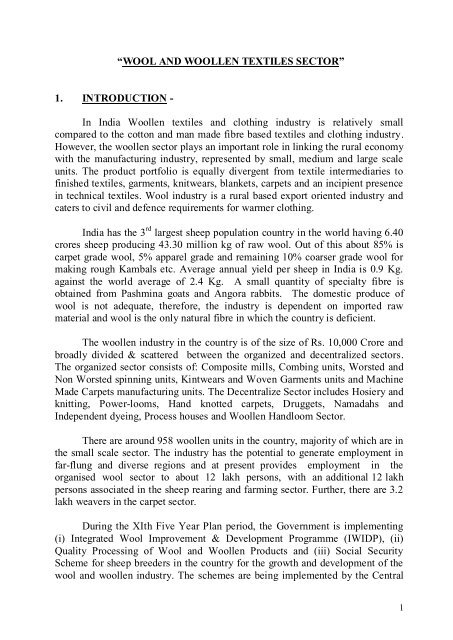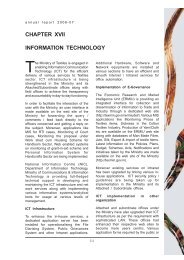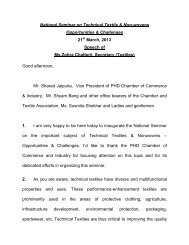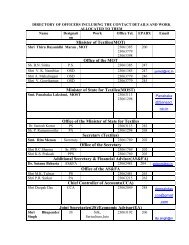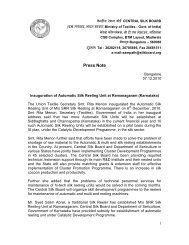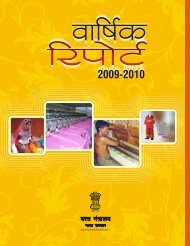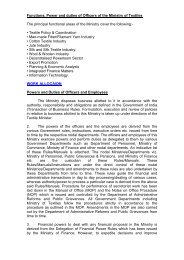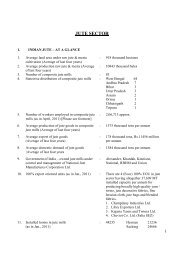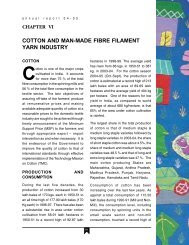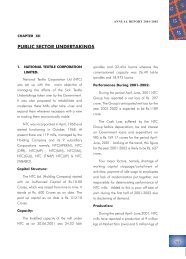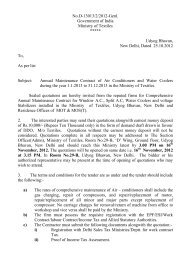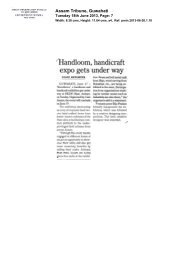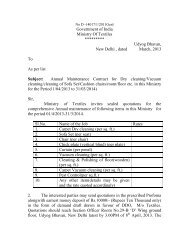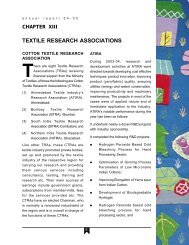Wool & Woollen Sector - Ministry of Textiles
Wool & Woollen Sector - Ministry of Textiles
Wool & Woollen Sector - Ministry of Textiles
- No tags were found...
Create successful ePaper yourself
Turn your PDF publications into a flip-book with our unique Google optimized e-Paper software.
“WOOL AND WOOLLEN TEXTILES SECTOR”1. INTRODUCTION -In India <strong>Wool</strong>len textiles and clothing industry is relatively smallcompared to the cotton and man made fibre based textiles and clothing industry.However, the woollen sector plays an important role in linking the rural economywith the manufacturing industry, represented by small, medium and large scaleunits. The product portfolio is equally divergent from textile intermediaries t<strong>of</strong>inished textiles, garments, knitwears, blankets, carpets and an incipient presencein technical textiles. <strong>Wool</strong> industry is a rural based export oriented industry andcaters to civil and defence requirements for warmer clothing.India has the 3 rd largest sheep population country in the world having 6.40crores sheep producing 43.30 million kg <strong>of</strong> raw wool. Out <strong>of</strong> this about 85% iscarpet grade wool, 5% apparel grade and remaining 10% coarser grade wool formaking rough Kambals etc. Average annual yield per sheep in India is 0.9 Kg.against the world average <strong>of</strong> 2.4 Kg. A small quantity <strong>of</strong> specialty fibre isobtained from Pashmina goats and Angora rabbits. The domestic produce <strong>of</strong>wool is not adequate, therefore, the industry is dependent on imported rawmaterial and wool is the only natural fibre in which the country is deficient.The woollen industry in the country is <strong>of</strong> the size <strong>of</strong> Rs. 10,000 Crore andbroadly divided & scattered between the organized and decentralized sectors.The organized sector consists <strong>of</strong>: Composite mills, Combing units, Worsted andNon Worsted spinning units, Kintwears and Woven Garments units and MachineMade Carpets manufacturing units. The Decentralize <strong>Sector</strong> includes Hosiery andknitting, Power-looms, Hand knotted carpets, Druggets, Namadahs andIndependent dyeing, Process houses and <strong>Wool</strong>len Handloom <strong>Sector</strong>.There are around 958 woollen units in the country, majority <strong>of</strong> which are inthe small scale sector. The industry has the potential to generate employment infar-flung and diverse regions and at present provides employment in theorganised wool sector to about 12 lakh persons, with an additional 12 lakhpersons associated in the sheep rearing and farming sector. Further, there are 3.2lakh weavers in the carpet sector.During the XIth Five Year Plan period, the Government is implementing(i) Integrated <strong>Wool</strong> Improvement & Development Programme (IWIDP), (ii)Quality Processing <strong>of</strong> <strong>Wool</strong> and <strong>Wool</strong>len Products and (iii) Social SecurityScheme for sheep breeders in the country for the growth and development <strong>of</strong> thewool and woollen industry. The schemes are being implemented by the Central1
<strong>Wool</strong> Development Board (CWDB), Jodhpur, through State GovernmentOrganizations/Non-Governmental Organizations.Installed Capacity and Employment:i) (a) <strong>Wool</strong> Combing(b) Synthetic fibre combing30 Million Kg3.57 Million Kgii) Worsted spindles 6.04 Lakhiii) Non Worsted spindles 4.37 Lakhiv) Power looms 7228v) (a) Machine made carpets(b) Hand-made carpets0.50 Mn Sq.Meter9 Mn. Sq. Metervi) Total number <strong>of</strong> units, including 958decentralized hosiery and shawl sector.vii) Total no. <strong>of</strong> persons employed, including 27.2 lakhpersons associated in sheep rearing andfarming sector and weavers in carpetsector.viii) Total ImportsRs. 2,143 Crore*ix) Total Exports Rs. 7,617 Crore*** <strong>Wool</strong>len yarn, raw wool and woollen/synthetic rags.** <strong>Wool</strong>len yarn fabric, made ups, ready made garments, carpet handmade1.1 WOOL & WOOLLEN INDUSTRY COMPRISES ORGANIZED ANDDECENTRALIZED SECTORS:(i) ORGANIZED SECTORa) Composite Millsb) Combing Unitsc) Worsted and Non-Worsted Spinning Unitsd) Knitwear and Woven Garments Unitse) Machine-made Carpet Manufacturing Units.(ii) DECENTRALIZED SECTORa) Hosiery and Knitting Unitsb) Powerloom Unitsc) Hand-made Carpet, Druggets and Namadahs unitsd) Independent Dyeing and Process Houses.2
Top 7 wool producing States :–SN States <strong>Wool</strong> Production2011-12(Qty. in million kg.)1 Rajasthan 13.1922 Karnataka 7.7793 Jammu & Kashmir 7.5304 Andhra Pradesh 4.9245 Gujarat 2.8196 Himachal Pradesh 1.6487 Uttar Pradesh 1.420Source : Animal Husbandry Deptt., <strong>Ministry</strong> <strong>of</strong> Agri.Production <strong>of</strong> Indian <strong>Wool</strong>len Items:-Production <strong>of</strong> oolen items HSCodeUnit 2009-102010-112011-12Worsted yarn 5107 Mil. Kgs 61.00 62.00 63.00<strong>Wool</strong>len yarn 5107 Mil. Kgs 30.00 30.50 31.00<strong>Wool</strong> tops 5105 Mil. Kgs 38.00 38.50 39.00Fabrics (<strong>Wool</strong>len/worsted ) 5112 Mil. Mtrs 87.00 88.00 89.00Shoddy yarn 5106 Mil. Kgs 42.00 43.00 44.00Blankets (Shoddy/<strong>Wool</strong>len) 6301 Mil. Pcs 20.00 22.00 25.00Shoddy fabrics 5103 Mil. Mtrs 31.00 32.00 34.00Knitted goods 6001 Mil. Kgs 20.00 21.00 22.00Handmade carpets 5701 Mil.Sq.Mtr 10.00 10.00 10.00Machine made carpets 5702 Mil.Sq.Mtr 00.40 0.45 0.46(Source : Indian <strong>Wool</strong>len Mills Federation, Mumbai. (IWMF)As per recent report <strong>of</strong> ‘National Fibre Policy’ (MOT), in the next onedecade, consumption (production + imports) <strong>of</strong> raw wool is estimated to doublefrom 114.2 million Kg in 2008-09 to 260.8 million Kg by 2019-20. During theperiod between 2009-10 and 2016-17 raw wool consumption is to be grow at aCAGR <strong>of</strong> 7.8% and will be approximately 208 Million Kg by end <strong>of</strong> 12 th Plan i.e.year 2016-17. As per past trends <strong>Wool</strong> production in the country is to be remainconstant at approx. 44 Million Kg and thus India will Import nearly 164 millionKg wool at the end <strong>of</strong> 12 th Plan.4
1.3 PROCESSINGThe <strong>Wool</strong>len industry suffers from inadequate and outdated processingfacilities. The pre-loom and post-loom facilities are required to be modernizedfor ensuring quality finished products. Quality finishing <strong>of</strong> the oolen productswill not only increase use <strong>of</strong> indigenous wool but will also make the productmore competitive in the international market. It will also assist in procuring betterprice for wool growers and will make quality raw material available to the Khadiand Handloom sector.Owing to overall size <strong>of</strong> the oolen industry and specialized nature <strong>of</strong>equipments required for processing, the industry has been dependent on importedplant and machinery except for few complimentary equipments from localsources. Machinery required for processing from raw wool fibre to fabricsfollowed by knitting and garmenting, is mostly imported from Europeancountries, USA and Japan.1.4 IMPORTThe production <strong>of</strong> wool in the country is not sufficient to meet the demand<strong>of</strong> the wool industry particularly <strong>of</strong> apparel sector and most <strong>of</strong> it is beingimported from Australia, New Zealand and many other countries. The presentrequirement <strong>of</strong> different segments <strong>of</strong> Indian oolen industry is likely to growfurther because <strong>of</strong> higher domestic as well as export need <strong>of</strong> oolen items.There has been a shift from imports <strong>of</strong> fine quality wool to low qualitywool in recent years. This is on account <strong>of</strong> consumer preference for hand tuftedcarpets in the US and other western markets. Cheap wool import from the MiddleEast is also constantly growing and is mixed with indigenous wool to make handtufted carpets.Import <strong>of</strong> raw wool from Australia, New Zealand and many other countriesare as under:Year Qty. (in million kgs.) Value (Rs. in crore)2006-07 99.56 1077.452007-08 93.07 1089.512008-09 65.73 1031.862009-10 68.26 1000.772010-11 94.77 1434.652011-12 76.29 1876.872012-13 77.16 1801.902013-14 (Upto Nov.,2013) 60.76 1314.44(Source: DGCI&S, Calcutta)5
Besides India is, we are also importing woollen and cotton rags etc. for theshoddy sector. The import figures <strong>of</strong> last years are as under:YearsQty.Value(in million kgs.) (Rs. in crore)2006-07 110.12 153.412007-08 91.81 96.032008-09 85.30 90.612009-10 82.65 89.672010-11 95.54 117.012011-12 140.51 235.302012-13 186.36 341.242013-14 (Upto Nov.,2013) 112.87 223.37(Source: DGCI&S, Calcutta)RAW WOOL IMPORTS FROM MAJOR COUNTRIESSN Country Qty. in tones (2012-13)1 Australia 139352 Pakistan 97023 New Zealand 52664 Syria 42055 Italy 30476 Turkey 2373(Source : DGCI&S, Calcutta )The import <strong>of</strong> raw material required by the woollen industry i.e. raw wooland woollen/synthetic rags is under Open General License (OGL).1.5 EXPORTIndia exports various woollen products like tops, yarn, fabrics, ReadyMade Garments and Carpets. Carpet enjoys maximum share <strong>of</strong> total export. Theaggregate export <strong>of</strong> woollen items from wool tops to finished products liketextiles, clothing, blankets and carpets is currently estimated around Rs. 7000Crs.During the 11 th Plan period, the growth was hindered owing to variety <strong>of</strong>factors. However there are good opportunities for export growth. Primary sectorswhich can look forward for export growth are textiles, woven clothings,knitwears and carpets. In order to build growth tempo, the action for reformshould be expedited which may also attract FDI to reinforce export outlookthrough joint ventures for better access to major markets.6
Item Wise Statement <strong>of</strong> Exports are as under:Year<strong>Wool</strong>en Yarn,fabrics, MadeupsReady MadeGarmentsValue (Rs.Crores)Carpet (Excluding silk)HandmadeTotal2006-07 379.28 1636.54 3891.47 5907.302007-08 373.57 1409.54 3725.79 5508.902008-09 456.51 1742.97 3505.37 5704.852009-10 424.63 1838.09 3442.93 5705.652010-11 501.20 1510.92 4706.68 6718.772011-12 725.20 1654.68 4051.21 6431.092012-13 659.03 1617.43 5340.77 7617.232013-14 (Upto 406.52 1341.62 4153.12 5901.27Nov.,2013)(Source : DGCI&S, Kolkata)Export to major countries : <strong>Wool</strong>en Yarn, Fabrics, Made UpsSN Country Value in Lakhs(2012-13)1 Italy 16064.562 USA 3276.343 United Kingdom 10161.214 China 670.625 Dominic Rep 13.46Source : DGCI&S, CalcuttaExport : Carpet-Excluding SilkSN Country Value in Lakhs(2012-13)1 USA 222947.862 Germany 61048.003 United Kingdom 49472.534 United Arab Emirates 29238.485 Belgium 5869.60( Source : DGCI&S, Calcutta )Export : Readymade Garments <strong>Wool</strong>SN Country Value in Lakhs(2012-13)1 USA 45717.312 United Kingdom 16664.223 France 12166.157
4 Germany 11451.905 United Arab Emirates 8009.45(Source : DGCI&S, Calcutta )1.6 RESEARCH & DEVELOPMENTResearch & Development activities should be promoted in the country tohelp the wool industry to adopt regular system <strong>of</strong> quality control and maintain thequality <strong>of</strong> products, to render technical and trouble shooting services withreference to selection <strong>of</strong> raw material, controlling various adjusting equipmentsand reducing the cost <strong>of</strong> production and improving the quality <strong>of</strong> product.Investment in R&D activities would help in following way Development <strong>of</strong> new products based on latest techniques in mechanicaland chemical processing <strong>of</strong> wool and transfer the knowhow to the industry. Study and provide Research & Development facilities for testing <strong>of</strong>properties <strong>of</strong> various products like fiber, yarn and fabric stages includingintermediate stages. The provision <strong>of</strong> services in quality assurance and testing to the organizedsector. The provision <strong>of</strong> services to the decentralized industry, which usessignificant Australian wool in small enterprises where the sophistication <strong>of</strong>equipment and machinery is much lower than that <strong>of</strong> the “organised”sector. Offer technical training and suitable courses to support industry’s need <strong>of</strong>technological/supervisory training for constant upgradation <strong>of</strong> technicalknowhow. Organizing regularly, workshops and seminars with the participation <strong>of</strong>industry experts from India as well as overseas in the field <strong>of</strong> wooltechnology for the dissemination <strong>of</strong> the latest development.1.7 HUMAN RESOURCE DEVELOPMENT PROGRAMMEIt has been felt that human resources development aspects have beenneglected in the wool sector. Since the Government has recognized the woolindustry as thrust area, it is necessary to make all out efforts for development <strong>of</strong>human resource to meet the requirements <strong>of</strong> wool industry.The woollen industry employs a workforce <strong>of</strong> 1.7 million and 30,000technical supervisory level personnel. With the spurt <strong>of</strong> the textile activity andthe projected target growth, while 5 million direct jobs are likely to be created inthe textile industry with another 7 million jobs in allied sectors, it is safe to8
estimate the requirement <strong>of</strong> about 2 lakh new jobs in the woollen sectorconsisting <strong>of</strong> skilled and semi-skilled workforce; in addition to trained /qualifiedsupervisory personnel & managers.1.8 CONSTRAINS FACED BY WOOL SECTOR : -(i) Raw <strong>Wool</strong> Production Low priority <strong>of</strong> State Governments in development <strong>of</strong> wool sector. Lack <strong>of</strong> awareness, traditional management practices, and lack <strong>of</strong> educationand poor economic conditions <strong>of</strong> woolgrowers. Shortage <strong>of</strong> pasture land which force breeders to migrate their flock from onearea to another throughout the year. Uneconomical return <strong>of</strong> the produces to sheep breeders i.e. sale <strong>of</strong> raw wool,live sheep, manure, milk, mutton, skin etc. Lack <strong>of</strong> motivation for adopting modern methods <strong>of</strong> sheep management,machine shearing <strong>of</strong> sheep, washing & grading <strong>of</strong> raw wool etc. Inadequate production and processing facilities <strong>of</strong> specialty fibres i.e.Pashmina goat wool and Angora rabbit wool.(ii) Marketing <strong>of</strong> Raw <strong>Wool</strong> Inadequate marketing facilities and infrastructure. Ineffective role <strong>of</strong> state wool marketing organizations in wool producingStates. Absence <strong>of</strong> organized marketing and minimum support price system forensuring remunerative return. Minimum return earned from sale <strong>of</strong> wool by wool growers.(iii) Processing <strong>of</strong> <strong>Wool</strong> Inadequate quantity <strong>of</strong> quality raw wool. Out dated and inadequate pre-loom & post-loom processing facilities. Inadequate dyeing facilities in wool potential areas. Need <strong>of</strong> designing & diversification <strong>of</strong> woolen handloom products. Dearth <strong>of</strong> technicians & trained manpower. Inadequate testing facilities and quality control measures. Transfer <strong>of</strong> technology is inadequate. Lack <strong>of</strong> operational and technical bench marks.(iv) Education, Research & Development, Human Resource Development No educational institute for wool technology resulting lack <strong>of</strong> expertise inwool sector. Inadequate database.9
Need <strong>of</strong> R&D work on blending <strong>of</strong> raw wool with other fibres &diversification <strong>of</strong> woollen products. Lack <strong>of</strong> R&D work for value addition to Deccani wool produced in Southernregion.2. CENTRAL WOOL DEVELOPMENT BOARD (CWDB), JODHPURThe Central <strong>Wool</strong> Development Board, Jodhpur was constituted by theGovernment <strong>of</strong> India, <strong>Ministry</strong> <strong>of</strong> <strong>Textiles</strong> in 1987 with the primary objective <strong>of</strong>development <strong>of</strong> wool and woollen textiles in the country by undertakingprogrammes to support various wool development activities. The Board hasundertaken various projects mainly in the wool growing States.The Standing Finance Committee (SFC) meeting to finalize <strong>Wool</strong> <strong>Sector</strong>has approved 12 th Plan schmes with total financial outlay <strong>of</strong> Rs. 96 Crore bymodifying the existing 11 th Plan schemes. The Board is implementingfollowing schemes for development <strong>of</strong> <strong>Wool</strong> <strong>Sector</strong> during the 12 th Five YearPlan :I. Integrated <strong>Wool</strong> Improvement and Development Programme (IWIDP) :A. Sheep and <strong>Wool</strong> Improvement Scheme (SWIS)B. Pashmina <strong>Wool</strong> Development Scheme (PWDS)C. Angora <strong>Wool</strong> Development Scheme (AWDS)D. Human Resource Development & Promotional activitiesII. Quality Processing <strong>of</strong> <strong>Wool</strong> and <strong>Wool</strong>len Products :- Setting up <strong>of</strong> Common Facility Centre for wool processing activities.III. Social Security Scheme for Sheep Breeders :A. Sheep Breeders Insurance SchemeB. Sheep Insurance SchemeBrief <strong>of</strong> schemes <strong>of</strong> <strong>Wool</strong> <strong>Sector</strong> : Central <strong>Wool</strong> DevelopmentBoardI. Integrated <strong>Wool</strong> Improvement and Development Programme(IWIDP)Under IWIDP, the Board is implementing different schemes for improvingquantity and quality <strong>of</strong> indigenous wool produced from Sheep, Angora Rabbit,Pashmina Goat along with training in all areas and associated promotional andmarketing activities with following schemes:10
(A)Sheep & <strong>Wool</strong> Improvement Scheme: (SWIS)The Board is implementing this scheme to improve the quality andquantity <strong>of</strong> sheep wool in all major wool producing States and providingfinancial assistance for ‘Health Care’ to animals, ‘Breed Improvement’ <strong>of</strong> sheep,‘Feed Supplement’ to eligible sheep and ‘Creation <strong>of</strong> Revolving Fund’ formarketing <strong>of</strong> raw wool.(B)Pashmina Development Scheme:Ladakh region produces the finest Pashmina wool (specialty fiber) in theworld which has high demand globally. Central <strong>Wool</strong> Development Board(CWDB) is implementing this scheme in Ladakh region to increase production<strong>of</strong> pashmina wool alongwith good return from sale <strong>of</strong> this wool to the Pashminawool growers with various components like : Buck Exchange Programme &Distribution <strong>of</strong> high quality Pashmina bucks for breed improvement, Assistancefor providing foundation stock in non-traditional areas, Training programmes,Establishment <strong>of</strong> Pasture Farms on migratory routes, Feed supplement to eligiblepashmina goats, Pashmina goat pens, providing portable tents, gumboots, tonomads, Health Coverage, Strengthening <strong>of</strong> existing Pashmina Fodder Banks &Breeding Farms, distribution <strong>of</strong> improved Pashmina Combs, Up-gradation <strong>of</strong>existing Pashmina Dehairing Plant at Leh.(C)Angora <strong>Wool</strong> Development SchemeThe CWDB is implementing this scheme in hilly areas <strong>of</strong> country tosupport Angora rearing activity by distribution <strong>of</strong> Angora rabbit among rearersalong with necessary training, feed, medicines, cages and shed construction etc.A new component (Integrated Angora Germplasm-cum-Processing and TrainingCenter) have been included in this 12 th Plan modified scheme for improvingangora wool production and processing activities to encourage the farmers toproduce angora products for better returns. The scheme has components like : (i)Establishment <strong>of</strong> Mini Angora rabbit Farm (ii) Angora Rabbit Germplasm-cum-Processing and Training Center.(D). Human Resource Development & Promotional activities:The Board has identified some areas for undertaking various trainingprogrammes in collaboration with various reputed organizations/ institutions/Departments on: Farm management for sheep; Angora & Pashmina rearing,sheep shearing by machines, wool grading & marketing, processing <strong>of</strong> wool andwoolens products, latest weaving and designing techniques to weavers. Thefollowing activities are also part <strong>of</strong> HRD & Promotional Activities: organizing11
fairs and <strong>Wool</strong>len Expos, seminar and workshops, Market Intelligence andPublicity, Publication <strong>of</strong> quarterly news magazine ‘<strong>Wool</strong> Ways’, R&D, Trainingunder Weaving and Designing Training Centre, running <strong>Wool</strong> Testing Centres.II.Quality Processing <strong>of</strong> <strong>Wool</strong> SchemeThe Board is implementing this scheme to create wool processing facilitiesfor improving quality <strong>of</strong> raw wool, finishing <strong>of</strong> woolens and value addition towool and woolens products. The project beneficiaries are State <strong>Wool</strong> Board/Corporation/ Non-Governmental Organization/ Registered Societies/PrivateEntrepreneurs etc. engaged in processing <strong>of</strong> wool and woolens. The CWDBprovides grant for procurement <strong>of</strong> machinery only upto limit <strong>of</strong> Rs. 50 lakh undereach Common Facility Centre for processing <strong>of</strong> wool and woolen.III. Social Security Scheme for Sheep BreedersThe Board is implementing this scheme to benefit the sheep breeders byproviding life insurance to them and their sheep flock by two plans (A) SheepBreeders Insurance Scheme and (B) Sheep Insurance Scheme. The basicobjective <strong>of</strong> these insurance plans is to provide enhanced insurance coverage tosheep breeders in the case <strong>of</strong> natural death/accidental death, total/partial disabilityand for their sheep flock, including fire, storm, flood and diseases contracted oroccurred during the period <strong>of</strong> the policy.4. 12 th PLAN HIGHLIGHTS :Special Package for Pashmina <strong>Wool</strong> Development in 12 th PlanIndia produces best quality Pashmina wool in the world. Presently,Pashmina wool is being produced in Ladakh region <strong>of</strong> India in small quantities.There are 2.45 lakhs Pashmina Goats in Ladakh region, which producesapproximately 40 to 50 Ton <strong>of</strong> raw Pashmina every year. The Pashminaproduced has excellent properties and products made from it are <strong>of</strong> very highvalue and also have export potential. Many nomad families in the region aredependent on rearing <strong>of</strong> Pashmina goats.Keeping in view the need for further development <strong>of</strong> Pashmina & demand<strong>of</strong> Pashmina wool in the market, it has decided to expand the Pashmina <strong>Wool</strong>Development scheme in 12 th Plan with approach <strong>of</strong> Special Package from theMOT.12
Central <strong>Wool</strong> Development Board (CWDB) is implementing modifiedPashmina <strong>Wool</strong> Development Scheme (PWDS) <strong>of</strong> 12 th Plan in Leh and Kargildistricts <strong>of</strong> Ladakh region for development <strong>of</strong> Pashmina wool and to increaseincome from this wool to Pashmina wool growers (Nomads) with the help <strong>of</strong>Ladakh Autonomous Hill Development Councils. PWDS has differentcomponents like : Buck Exchange Programme & Distribution <strong>of</strong> high qualityPashmina bucks for breed improvement, Assistance for foundation stock in nontraditionalareas, Training programmes, Feed supplement to eligible pashminagoats, Pashmina goat pens, providing portable tents, gumboots to nomads,Health Coverage, Strengthening <strong>of</strong> existing Pashmina Fodder Banks & BreedingFarms, distribution <strong>of</strong> improved Pashmina Combs, Up-gradation <strong>of</strong> existingPashmina Dehairing Plant at Leh with total financial outlay <strong>of</strong> Rs. 41.21 Crore tobenefit 2 lakh Pashmina goats and its 800 families.Scheme-wise distribution <strong>of</strong> 12 th Five Year Plan outlay and physical targetsunder <strong>Wool</strong> & <strong>Wool</strong>len <strong>Sector</strong>(Rs. in Crore)SN Name <strong>of</strong> Scheme Physical target <strong>of</strong> 12 th Plan FinancialI Integrated <strong>Wool</strong> Improvement & Development ProgrammeABCDIIIII(IWIDP)Sheep & <strong>Wool</strong>Improvement Scheme(SWIS)Pashmina <strong>Wool</strong>Development SchemeAngora <strong>Wool</strong>Development SchemeHuman ResourceDevelopment &Promotional ActivitiesQuality Processing <strong>of</strong><strong>Wool</strong> Scheme – CFCfor Integrated <strong>Wool</strong>Processing FacilitiesSocial SecurityScheme – Insurance <strong>of</strong>Sheep and SheepBreedersTo cover 28 lakh sheep, 10 BreedingFarms, Feed Supplement to 75,000sheepTo cover 2 lakh Pashmina goats, 3MPEC, 3 Pasture Farms, Feed to 40,000goats, 1 Dehairing PlantTo cover 2200 Angora rabbits, benefit100 families & 2 Germplasm &Processing CentresTo train 1200 persons, to run WDTC,WTC & setting up CFCs for training,36 <strong>Wool</strong>len Expos, R&D, Seminars,publishing news magazineTo set up 6 Common Facility Centres(CFC) for pre-loom wool processingfacilities @ Rs. 50 lakh per CFC(Maximum assistance)To benefit 75,000 shepherds & 4 lakhsheep under insurance <strong>of</strong> (i) SheepBreeders Insurance scheme and (ii)Sheep Insurance Scheme31.0041.212.4916.303.002.00TOTAL outlay for 12 th Plan 96.0013
5. BUDGETORY SUPPORT :i) Annual Plan 2012-13 :For the year 2012-13, it was decided to continue on-going schemes <strong>of</strong>11 th Plan under <strong>Wool</strong> and <strong>Wool</strong>len <strong>Sector</strong> with total financial allocation <strong>of</strong> Rs.13.50 Crore in absence <strong>of</strong> approval <strong>of</strong> 12 th Plan programme. In the year 2012-13,the Board has fully utilized financial allocation <strong>of</strong> Rs. 13.50 Crore and followingachievements were made : Benefited 12.15 lakh sheep <strong>of</strong> Rajasthan, Uttarakhand, Maharashtra, U.P., J.&K. & Ladakh region under Sheep & <strong>Wool</strong> Improvement Scheme (SWIS) toimprove quality and quantity <strong>of</strong> indigenous wool. Provided Feed Supplement to one lakh eligible sheep/Pashmina goats <strong>of</strong>Ladakh region (Leh & Kargil districts) during severe/adverse period <strong>of</strong> cold. Strengthened the Sheep Breeding Farms <strong>of</strong> different State Govts. forimproving good quality breedable rams. Provided support for marketing <strong>of</strong> raw wool in different States to ensureremunerative returns to wool growers for their produce (wool). Established 2 Common Facility Centres (CFCs) under Quality Processing <strong>of</strong><strong>Wool</strong> scheme for creating wool processing facilities. Covered 800 families under Pashmina <strong>Wool</strong> Development Scheme <strong>of</strong> Ladakh. Provided training to 100 persons under different activities like weaving <strong>of</strong>woollen handloom products at Weaving & Designing Training Centre &farmers under Angora rabbit, sheep rearing, sheep shearing machines. Organized 18 <strong>Wool</strong>len Expos (Exhibition-cum-sale <strong>of</strong> woollen products) atdifferent cities for providing support for marketing <strong>of</strong> woollen products towoollen artisans/weavers engaged in manufacturing <strong>of</strong> woollen products. Covered 10,919 shepherds under Sheep Breeders Insurance Scheme indifferent States during 2012-13.ii) Annual Plan 2013-14 :For the financial year 2013-14, Rs. 16 Crore has allocated under Planfund to CWDB for implementation <strong>of</strong> its different schemes in all wool producingStates and following achievements were made upto Dec.,2013: Benefited 6 lakh sheep <strong>of</strong> Himachal Pradesh and Maharashtra States underSheep & <strong>Wool</strong> Improvement Scheme (SWIS) to improve quality and quantity<strong>of</strong> indigenous wool.14
Provided Feed Supplement to 1.15 lakh eligible sheep & Pashmina goats <strong>of</strong>Ladakh region (Leh & Kargil districts) during severe/adverse period <strong>of</strong> cold. Strengthened two Sheep Breeding Farms in U.P. State. for improving goodquality breedable rams. Provided support for marketing <strong>of</strong> raw wool in Andhra Pradesh and Lehdistrict <strong>of</strong> Ladakh region to ensure remunerative returns to wool growers fortheir produce (wool). Covered 800 families under Pashmina <strong>Wool</strong> Development Scheme <strong>of</strong> Ladakh. Sanctioned 3 projects under Angora <strong>Wool</strong> Development Scheme to cover1000 angora rabbits <strong>of</strong> H.P. State. Sanctioned Rs. 6 crore to <strong>Wool</strong> Research Association, Thane to upgrade three<strong>Wool</strong> Testing Laboratories <strong>of</strong> CWDB & WRA at Bikaner, Kullu and Thane. Provided training to 90 women under weaving <strong>of</strong> woollen handloom productsat Weaving & Designing Training Centre, Kullu. Organized 8 <strong>Wool</strong>len Expos (Exhibition-cum-sale <strong>of</strong> woollen products) atdifferent cities for providing support for marketing <strong>of</strong> woollen products towoollen artisans/weavers engaged in manufacturing <strong>of</strong> woollen products. Covered 30,519 shepherds under Sheep Breeders Insurance Scheme and32,633 sheep under Sheep Insurance Scheme.6. FUTURE PLANS :The Government, for the holistic growth and development <strong>of</strong> <strong>Wool</strong> <strong>Sector</strong>,is making serious efforts to :‣ To improve quality and quantity <strong>of</strong> wool (carpet grade, specialty wool fibres suchas Angora & Pashmina, apparel grade and deccani grade wool). Improve fineness<strong>of</strong> wool by 2 (micron) and increase wool yield per animal by 10%.‣ Reduce mortality rate <strong>of</strong> sheep and Pashmina goats by 10% to bring downmortality rate from current rate <strong>of</strong> 12-15% to 5-7%.‣ Setting up Common Facility Centres (CFCs) for creating processing facilities forwool and woolens.‣ To increase employment in wool and allied industry and fulfill requirement <strong>of</strong>skilled manpower and also trained to wool growers with new techniques.‣ To provide quality stud rams, pashmina bucks and angora rabbits as foundationstock to improve breed <strong>of</strong> good quality wool producing animals.‣ Widen the uses <strong>of</strong> the coarse and colored Deccani wool (Southern region) byproduct development and product diversification.‣ Improve wool production in rain fed areas by providing feed supplement toeligible (weak & pregnant) sheep and pashmina goats.15
‣ To induce generic promotion <strong>of</strong> quality speciality fibres like Pashmina goats andangora rabbits.‣ To benefit wool growers under Social Security Scheme <strong>of</strong> Govt. <strong>of</strong> India.‣ To strengthen State <strong>Wool</strong> Marketing Organizations for marketing facility for rawwool and to ensure remunerative returns to wool growers.‣ Increase the demand for Indian wool in domestic and international market.Data Compiled by: Central <strong>Wool</strong> Development BoardData Source: <strong>Wool</strong> Section Updated on: 17/01/201416


